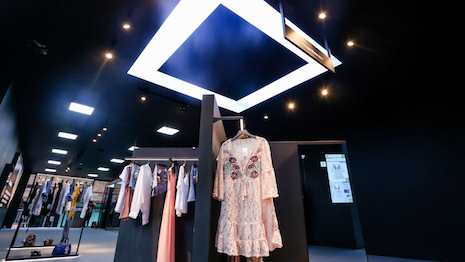- About
- Subscribe Now
- New York,
July 24, 2018

 Alibaba has opened up an artificial intelligence-enabled concept store. Image Credit: Alibaba
Alibaba has opened up an artificial intelligence-enabled concept store. Image Credit: Alibaba
Retailers are looking to bridge the gap between physical and digital, as even tech-savvy consumers continue to prefer shopping at bricks-and-mortar stores.
According to Fashionbi’s “Phygital Stores: How New Age Stores Are Changing The Way We Shop” report, shoppers are looking for more customized experiences in-store. A growing number of retailers are incorporating technology to improve customer service and harness more information about their customers.
“The biggest advantage of digital technology is an ability of data gathering and analysis,” said Yana Bushmeleva, chief operating officer at Fashionbi, Milan. “We all speak about the importance of the personalized shopping experience, and thanks to the store digitalization such experience can be provided.”
Digital footsteps
Digital media cannot replace the sensory and social experiences that come with shopping at physical stores.
Despite the growing popularity of ecommerce, weekly bricks-and-mortar shoppers have actually increased, from 40 percent in 2015 to 44 percent in 2018.
The majority of shoppers still prefer to shop at physical stores. Image credit: Rinascente.
Most shoppers have already interacted with retailers through multiple channels, such as social media or brand Web sites, before setting foot in stores. Customers also expect their relationship with the brand to continue after checkout.
Retailers can leverage positive shopping experiences to encourage customers to leave feedback in exchange for further discounts or other customized benefits.
Integrating technology at physical stores, making them “phygital,” is crucial if retailers want to follow customers’ digital footprints.
Department store chain Barneys New York was among the first luxury department stores to integrate iBeacon technology and a personalization platform within a bricks-and-mortar space.
The iBeacons are placed throughout Barneys' Chelsea flagship and are linked to the Relevance Cloud platform. The technology enhances the in-store experience by delivering personalized notifications and editorial content such as copy, video and look books to consumers.
Internally, Barneys' use of Relevance Cloud is beneficial to its sales team, which can use the platform to connect online and offline behavior and preferences. Access to this data can help sales associates better assist Barneys' in-store consumers with the retailer’s clienteling application (see story).
Not only are retailers offering services to help customers’ purchase journey in-store, but they are also introducing augmented and virtual reality to encourage customers to interact more within the store space.
Instagram post from Balmain introducing its VR experience
Earlier this spring, French fashion house Balmain opened its first Italian flagship in Milan that included a virtual reality experience so consumers could further immerse themselves in the brand’s universe.
The brand set up a temporary lounge where consumers could put on a specially designed Oculus headset to take a virtual tour of Paris guided by Balmain creative director Olivier Rousteing. “My City of Lights” followed the designer’s emotional journey as he creates each runway collection, taking consumers into the process (see story).
Beauty brands especially are using AR to positive effect in stores.
For instance, personal care group Coty Inc. has introduced in-store AR-powered mirrors that interact with physical products.
With this mirror, customers can grab products off the shelves and bring them to their reflection. There, the augmented reality technology of the mirror will automatically project the color onto their lips so they can see what it will look like once purchased.
The feature is unique in that it combines the tactile, physical experience of looking at a product and holding it in one's hands with the digital experience of projecting different products onto one's face through AR (see story).
Nonetheless, these exciting new features may present challenges to shoppers and retailers alike.
"During our field research, we saw many examples of digital screens and magic mirrors which simply didn't work or were switched off by the store staff," Ms. Bushmeleva said. "We were also observing the customers at the stores, and in many cases the tablets, digital panels were unnoticed and ignored."
Tech-savvy shopping
While traditional retailers look to bring more digital options to their physical stores, ecommerce retailers are looking to attract shoppers who value being able to experience products before completing their purchases.
Online retail giant Amazon continues to undercut the traditional bricks-and-mortar model with the introduction of a try-before-you-buy service, dubbed Prime Wardrobe.
Similar to a trunk service, Amazon’s Prime Wardrobe sends Prime subscribers a box filled with clothes. The service is free for Prime members and does not include a styling fee, a common add-on for similar services (see story).
One of Amazon's rivals, Chinese ecommerce giant Alibaba opened “FashionAI,” a temporary concept store that harnessed artificial intelligence capabilities for a stress-free shopping experience.
"Smart mirrors" located throughout the store displayed product information when nearby shoppers touched or picked up a garment. Data collected by the smart mirrors could help retailers learn about what items are popular among shoppers, as well as help track their movement around stores (see story).
Traditional and ecommerce retailers will continue to borrow methods from one another as the lines between physical and online shopping continue to blur.
"I believe that the future innovations will be more practical rather than focus on the entertainment of a customer," Ms. Bushmeleva said. "The store digitalization should be done in a smart way and should be useful for both parties, customers — convenient and useful experience — and brand — additional data on customers behavior and preferences."
Share your thoughts. Click here